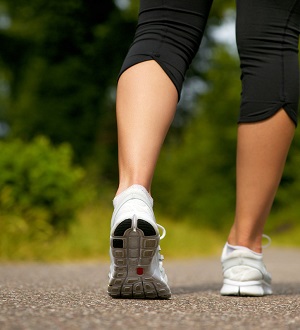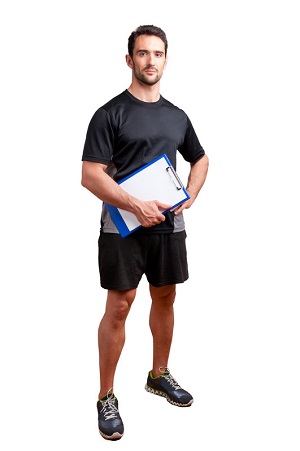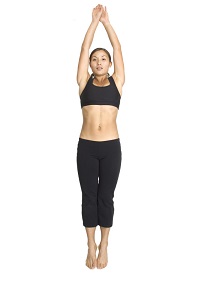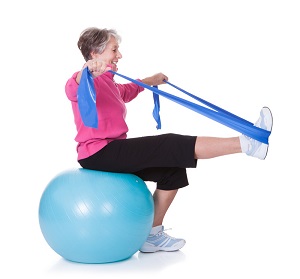 High-intensity interval training, or HIIT is an enhanced form of interval training, an exercise strategy alternating periods of short intense anaerobic exercise with less-intense recovery periods. HIIT is a form of cardiovascular exercise. Usual HIIT sessions may vary from 4 to 30 minutes. These short, intense workouts provide improved athletic capacity and condition, improved glucose metabolism, and improved fat burning.
High-intensity interval training, or HIIT is an enhanced form of interval training, an exercise strategy alternating periods of short intense anaerobic exercise with less-intense recovery periods. HIIT is a form of cardiovascular exercise. Usual HIIT sessions may vary from 4 to 30 minutes. These short, intense workouts provide improved athletic capacity and condition, improved glucose metabolism, and improved fat burning.
Don’t expect this short workout to be a walk in the park. It is very intense if done right and because of its intense nature it will have you burning fat throughout the day long after you finished the routine.
A session of HIIT often consists of a warm up period, followed by 3 to 10 repetitions of high intensity exercise, separated by medium intensity exercise for recovery, and ending with a period of cool down exercise. The high-intensity portion of the workout should be done at near maximum intensity.
High-intensity interval training is a versatile type of training program because you can include a wide range of activities with it. Treadmill, jump rope, sprint exercises can be turned into a great routine. An activity that utilizes the largest muscle groups in the body provides the most benefit since high intensity taps the energy sources found there.
Those on the road to weight loss can benefit most from this anaerobic routine. Not only does it prevent you from hitting a plateau, it keeps your workout routines challenging and interesting. There are different kinds of HIIT programs that suit the varying fitness levels of each individual. These are: 1) the 30-second interval workout, 2) the 60-second interval workout, 3) Tabata training and 4) Body for Life HIIT programs mentioned below, sufficient warm ups and cool downs are a must.
The 30-second interval training workout is the most recommended for beginners. For starters, you can begin by doing 30-second sprints followed by 90 seconds of rest for 6 sets. Push your body even at the beginning so that you feel that the last few seconds seem impossibly hard.
If you want to a direct fat burning workout, the 60-second interval training workout is highly recommended since it will exhaust your muscles of whatever stored energy they have.
The Tabata HIIT is by far the most unique and yet the most effective, comparable to the muscular endurance built by 45 minutes of normal cardio training. The whole workout only lasts 4 minutes. This makes the Tabata workout not only ideal for weight loss but also for improving your performance in any aerobic or anaerobic sport.
The Body for Life HIIT program is composed of four sets of increasing intervals with each interval lasting one minute long. Each set is four minutes long. Intensity is a major factor in this particular HIIT program. Start this workout at an intensity of 6 out of 10 which can be likened to a fast jog. Heighten your intensity so that each set excluding the last set, with the intensity of 9. At the last set, extend the set by one full minute going for an intensity of 10 such that you feel your energy reserves have already been depleted. At this time, go back up to full pace and hold there for as long as possible even if by this time it’s next to impossible to do so.
Sprints are one of the most commonly used exercises in a training program. If you happen to have a preexisting injury that might be strained by a particular program, you can find other exercises that would be more suited for your condition. Make sure your trainer knows your limitations so they can set up a program that is suitable for your capabilities.
A HIIT workout without anything else is not a complete regime, this is only a small part of your weekly exercise routine. HIIT workouts can be done 2-3 times a week on a non weightlifting day. You also need to make sure that you have the energy needed to sustain your routine for that particular day by eating healthy an hour before your exercise.
For more articles go to http://clubonefitness.lifestyleezine.com

 Walking is an incredible form of exercise which can be carried out by most people. It’s a low impact workout which carries a very low risk of injury. It is an activity that can easily be added to your current workout routine or a way to get started on the path to reach your workout goals.Walking regularly will keep you physically healthy. Fitness experts and physicians agree that even a short walk can do wonders for the human body. It can strengthen the cardiovascular system by exercising the heart, and it reduces blood pressure and increases circulation. It is reasonably aerobic (increases your oxygen intake and lung capacity) and of course is low impact – it’s easy on the feet, ankles and knees. Regular walking strengthens your muscular and skeletal systems and reduces the likelihood of arthritis and other bone and muscle disorders that come with aging. It helps lower the bad cholesterol and increase the good, and it decreases the risk of developing type II diabetes. Walking for fitness can also help you lose weight.
Walking is an incredible form of exercise which can be carried out by most people. It’s a low impact workout which carries a very low risk of injury. It is an activity that can easily be added to your current workout routine or a way to get started on the path to reach your workout goals.Walking regularly will keep you physically healthy. Fitness experts and physicians agree that even a short walk can do wonders for the human body. It can strengthen the cardiovascular system by exercising the heart, and it reduces blood pressure and increases circulation. It is reasonably aerobic (increases your oxygen intake and lung capacity) and of course is low impact – it’s easy on the feet, ankles and knees. Regular walking strengthens your muscular and skeletal systems and reduces the likelihood of arthritis and other bone and muscle disorders that come with aging. It helps lower the bad cholesterol and increase the good, and it decreases the risk of developing type II diabetes. Walking for fitness can also help you lose weight. Have you decided to hire a personal trainer to help you lose weight or build up your body? Personal training is a simple way to help you achieve your fitness goals that you can sometimes have trouble attaining on your own. You can reap many benefits from partnering with a fitness expert who can guide your efforts safely and effectively.One of the most important things to do is select the right trainer for the job. Make sure that you pick an experienced trainer with the necessary qualifications. An excellent trainer makes a huge difference to the quality of workout you will get. You need to have a clear discussion with your trainer about what your fitness goals are. This is the only way to ensure that you get the most appropriate training. Your decision should cover your long term and short term goals and also the steps you have to take to achieve them all. You should also communicate clearly that you are serious about the personal training sessions and will put in all the effort required to achieve the goals. You want to be taken seriously by your trainer.
Have you decided to hire a personal trainer to help you lose weight or build up your body? Personal training is a simple way to help you achieve your fitness goals that you can sometimes have trouble attaining on your own. You can reap many benefits from partnering with a fitness expert who can guide your efforts safely and effectively.One of the most important things to do is select the right trainer for the job. Make sure that you pick an experienced trainer with the necessary qualifications. An excellent trainer makes a huge difference to the quality of workout you will get. You need to have a clear discussion with your trainer about what your fitness goals are. This is the only way to ensure that you get the most appropriate training. Your decision should cover your long term and short term goals and also the steps you have to take to achieve them all. You should also communicate clearly that you are serious about the personal training sessions and will put in all the effort required to achieve the goals. You want to be taken seriously by your trainer.  As babies and toddlers, we were able to squat for hours. It is actually considered a resting position in many cultures. A person’s ability (or inability) to squat is a good indication of his or her physical condition. One must not only possess a flexible body, but also have well-developed leg and back muscles. Although we were exceptionally good at it long ago, the lack of practice in squatting could render a person incapable of squatting, or to maintain the squatting position for more than a minute. Full squatting involves resting one’s weight on the feet with the buttocks resting on the backs of the calves. Most western adults cannot place their heels flat on the ground when squatting because of shortened Achilles tendons largely caused by habitually sitting on chairs or seats and wearing shoes with heels (especially high heels). For this reason the squatting position is usually not sustainable for more than a few minutes as heels-up squatting is a less stable position than heels-down squatting. With continual practice, we can get back to the full squat position we were used to as a child.
As babies and toddlers, we were able to squat for hours. It is actually considered a resting position in many cultures. A person’s ability (or inability) to squat is a good indication of his or her physical condition. One must not only possess a flexible body, but also have well-developed leg and back muscles. Although we were exceptionally good at it long ago, the lack of practice in squatting could render a person incapable of squatting, or to maintain the squatting position for more than a minute. Full squatting involves resting one’s weight on the feet with the buttocks resting on the backs of the calves. Most western adults cannot place their heels flat on the ground when squatting because of shortened Achilles tendons largely caused by habitually sitting on chairs or seats and wearing shoes with heels (especially high heels). For this reason the squatting position is usually not sustainable for more than a few minutes as heels-up squatting is a less stable position than heels-down squatting. With continual practice, we can get back to the full squat position we were used to as a child. Treadmill exercise has been proven to be beneficial for all kinds of people, including at risk groups like older individuals and pregnant women. Some kinds of aerobic exercises do not suit pregnant women or older people, but walking is always recommended and a treadmill is ideally suited for this purpose. Cardio-vascular exercise derived from walking or running on a treadmill helps you to burn extra calories and will help you to lose weight rapidly if you exercise on a frequent and consistent basis. A treadmill adds consistency to your walking workout and you can set both the pace and duration of your session and increase this in order to achieve a progressive improvement over time. A treadmill can also help you to achieve your personal fitness goals.
Treadmill exercise has been proven to be beneficial for all kinds of people, including at risk groups like older individuals and pregnant women. Some kinds of aerobic exercises do not suit pregnant women or older people, but walking is always recommended and a treadmill is ideally suited for this purpose. Cardio-vascular exercise derived from walking or running on a treadmill helps you to burn extra calories and will help you to lose weight rapidly if you exercise on a frequent and consistent basis. A treadmill adds consistency to your walking workout and you can set both the pace and duration of your session and increase this in order to achieve a progressive improvement over time. A treadmill can also help you to achieve your personal fitness goals. A dancer’s body looks so fit – they must get a good workout. There must be some tricks of the trade that can be applied to our every day workout to get some of the same effects. Dance-type exercises will focus more on muscle development and flexibility. Dancers are serious athletes that are continually working out to improve strength, agility, speed, flexibility and cardiovascular endurance in order to prevent injuries. Most people know that they have to exercise to maintain a healthy lifestyle, but it is getting motivated to exercise that is the difficult part. Exercise need not be boring – try dancing!
A dancer’s body looks so fit – they must get a good workout. There must be some tricks of the trade that can be applied to our every day workout to get some of the same effects. Dance-type exercises will focus more on muscle development and flexibility. Dancers are serious athletes that are continually working out to improve strength, agility, speed, flexibility and cardiovascular endurance in order to prevent injuries. Most people know that they have to exercise to maintain a healthy lifestyle, but it is getting motivated to exercise that is the difficult part. Exercise need not be boring – try dancing! If you are an athlete who takes part is sports that require speed, agility and vertical power such as basketball and volleyball, then a plyometric workout will enhance your game. Plyometrics are specifically designed to help increase your vertical leap and better your ability to explode into sudden bursts of speed.Plyometrics leads to better body posture, improved balance and flexibility. Plyometric workouts come in many shapes and forms depending on the specific goals of the athlete. Having a regular plyometric workout is an important part of any strength and conditioning program. It is suggested that you do plyometrics only three or four days a week. Doing it every day could cause serious damage to your body. It is important to give yourself ample rest in between workouts to avoid injury.
If you are an athlete who takes part is sports that require speed, agility and vertical power such as basketball and volleyball, then a plyometric workout will enhance your game. Plyometrics are specifically designed to help increase your vertical leap and better your ability to explode into sudden bursts of speed.Plyometrics leads to better body posture, improved balance and flexibility. Plyometric workouts come in many shapes and forms depending on the specific goals of the athlete. Having a regular plyometric workout is an important part of any strength and conditioning program. It is suggested that you do plyometrics only three or four days a week. Doing it every day could cause serious damage to your body. It is important to give yourself ample rest in between workouts to avoid injury. Seasonal affective disorder (SAD) also known as winter depression, winter blues or seasonal depression is a mood disorder that affects many during the dark, cold winter months. People experience mood changes during the winter that find them sleeping more, having little energy and may also leave them feeling depressed. Adding a good dose of daily exercise can help beat these mood changes.
Seasonal affective disorder (SAD) also known as winter depression, winter blues or seasonal depression is a mood disorder that affects many during the dark, cold winter months. People experience mood changes during the winter that find them sleeping more, having little energy and may also leave them feeling depressed. Adding a good dose of daily exercise can help beat these mood changes. People exercise for many different reasons. Some want to lose weight, reach a fitness goal or because their Doctor said they should, but did you know that exercise is one of the best ways to stay young? Feeling and looking young is an attitude and part of that is feeling healthy and having minimal stress. Exercise can help with both of these states of mind. Exercise will also help you to look younger which can improve your confidence. What exercises should you do to stay young? Here are a few examples.
People exercise for many different reasons. Some want to lose weight, reach a fitness goal or because their Doctor said they should, but did you know that exercise is one of the best ways to stay young? Feeling and looking young is an attitude and part of that is feeling healthy and having minimal stress. Exercise can help with both of these states of mind. Exercise will also help you to look younger which can improve your confidence. What exercises should you do to stay young? Here are a few examples.  Still wondering how to fit exercise into a busy schedule? Your days are filled from the time you get up until the time you fall into bed exhausted at night, but believe it or not, you still have time to fit some exercise into your day. Here are six ways that you can use to fit exercise into your already busy schedule.
Still wondering how to fit exercise into a busy schedule? Your days are filled from the time you get up until the time you fall into bed exhausted at night, but believe it or not, you still have time to fit some exercise into your day. Here are six ways that you can use to fit exercise into your already busy schedule.